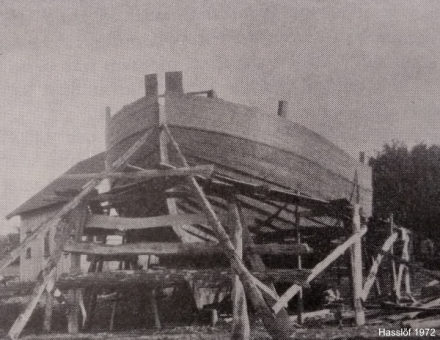History
In 1994 during excavation work for the closing of a river near Sundsvall in Sweden, pieces of a shipwreck were found. C-14 dating showed that these remains were from the first half of the 15th century. It was given a protected status to be researched later. The wreck was named after its finding place.
The wreck was discovered in the Selångersån council at a shallow depth of between 0.3 to 2 metres. This site once formed a natural harbour until the 17th century, but has been subject to post-glacial land-rise, which explains the shallowness of the site today.
The wreck was first surveyed in 2000 under M. Holmqvist of the Länsmuseet Västernorrland and monitored by local divers, who reported the ongoing destruction of the wreck as a consequence of currents and ice floes.
In October 2006, divers of the National Maritime Museum carried out a survey under the lead of Niklas Eriksson.
Description
The bottom portion of the wreck has survived intact with the keel, floor-timbers and stringers present, preserved up to the fifth strake. The planks are fastened in the clinker-technique. Several top-timbers from the site, however, indicate that the characteristic joggled recesses indicative for lapstrake/clinker-fastened planks are absent in the upper part of the hull, evidently completed by flush-laid (carvel) planks above the waterline. Thus, the vessel would have appeared like a carvel-vessel when it was afloat.
Such a type has been addressed as halvkravell ('half-carvel') by the Swedish ethnographer Olof Hasslöf, who interviewed a boat builder who built a similar vessel in the 1930's.

The term 'half-carvel' is slightly misleading though, as the vessel is essentially a shell-first, clinker-built construction and only a carvel by its appearance.
The 'half-carvel' phenomenon is mostly associated with northern Sweden between the 16th-20th century, but comparable finds are also known from Norway, Denmark, Germany and the Netherlands.
| Length | 55 ¾ feet (17 m) |
|---|
Status
The site is subject to further deterioration caused by currents and ice floes, as well as the post-glacial landrise, through which the upper portion of the wreck could protrude above the water-line in a matter of several years.
References
- Eriksson, N. (2008).
An early “half-carvel” in the Northern Baltic.
Maritime Archaeology Newsletter from Denmark 23.
pp 4-9. - Eriksson, N. (2008).
En fartygslämning från slutet av 1500-talet i Selångersån, Arkeologisk förundersökning.
Statens Maritima museer: Arkeologisk Rapport 2008.
pp 6. - Eriksson, N. (2010).
Between Clinker and Carvel: Aspects of hulls built with mixed planking in Scandinavia between 1550 and 1990.
Archaeologia Baltica, 14.2.
pp 77-84. - Hasslöf. O. (1970).
Huvudlinjer I skeppsbyggnadskonstens teknologi.
pp 28–73.
København.